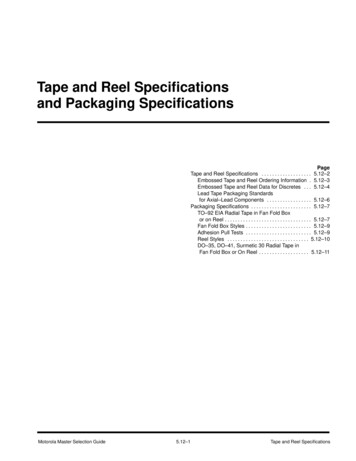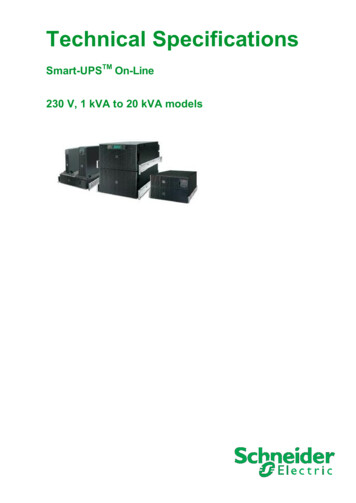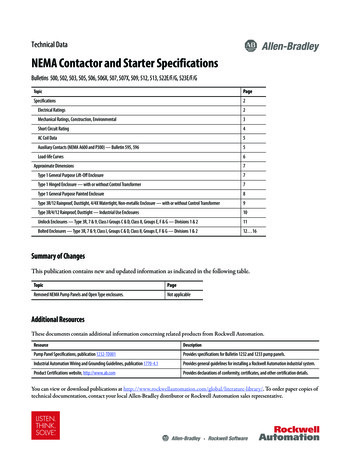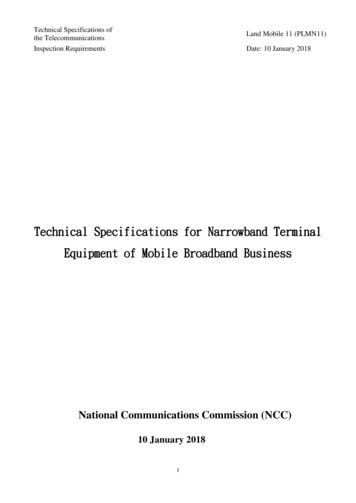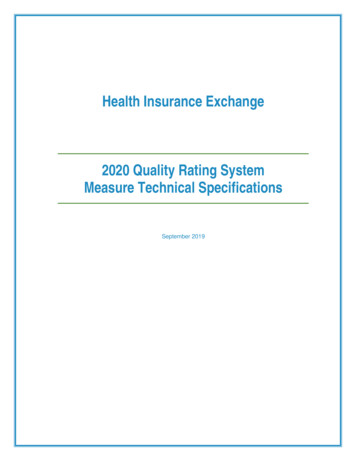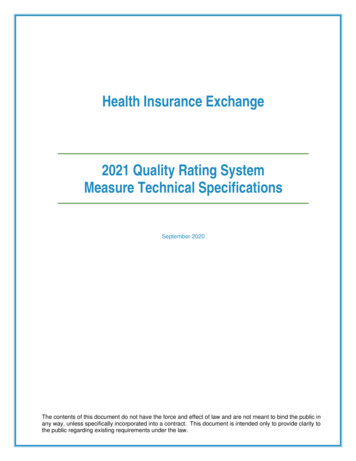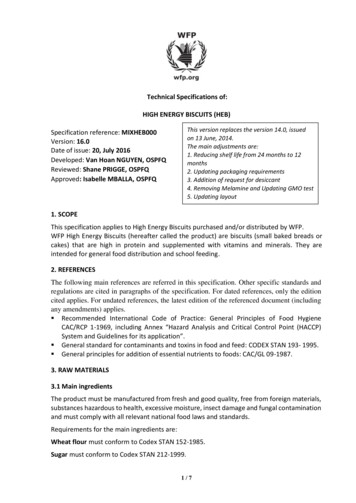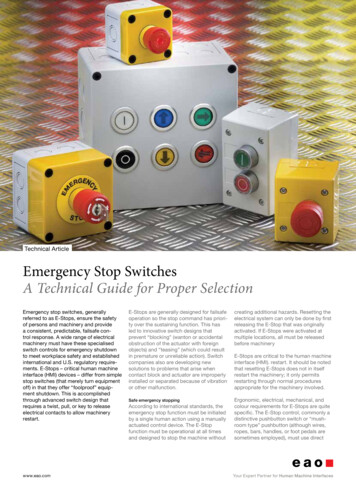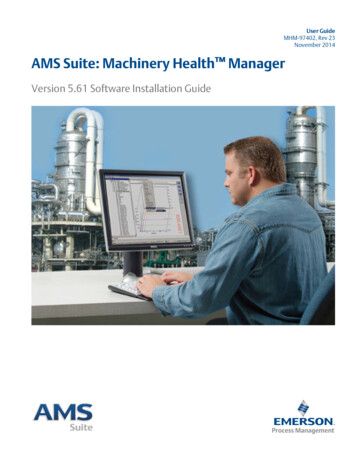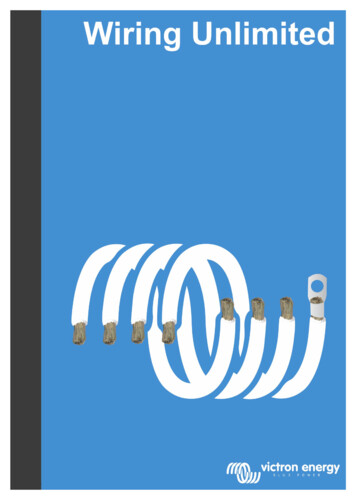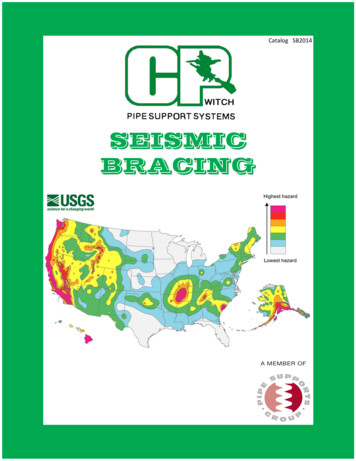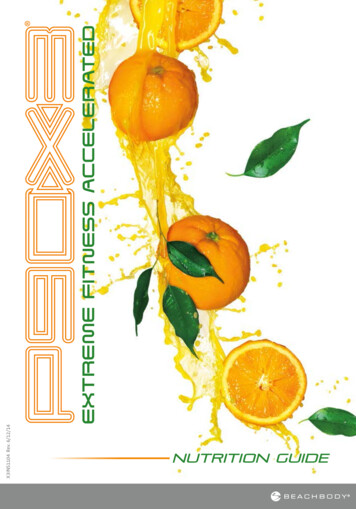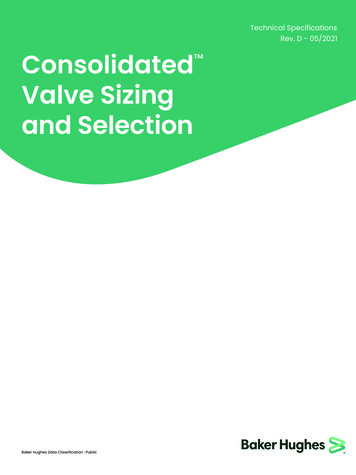
Transcription
Technical SpecificationsRev. D - 05/2021ConsolidatedValve Sizingand Selection Baker Hughes Data Classification : Public
2 Baker Hughes 2021 Baker Hughes Company. All rights reserved.
Table of ContentsIntroduction.4Formula Symbols.5Set Pressure and Overpressure.6API Sizing Formulas.8ASME Sizing Formulas.9Correction Factors.11Fluid Properties. 14API Standard Orifice Areas1900. 162900.173900 and 4900. 1819000. 191982 and 13900.20Superheat Correction Factors . 21Rupture Disk Combination. 23API Fire Sizing.24 2021 Baker Hughes Company. All rights reserved.Consolidated Valve Sizing and Selection 3
IntroductionAPI SizingFlow Coefficient K (Coefficient of Discharge)API establishes rules for sizing of pressure relief devicesin the standard API RP 520. This recommended practiceaddresses only flanged spring loaded and pilot operatedsafety relief valves with a D - T orifice. Valves smaller orlarger than those with a D - T orifice are not addressed byAPI RP 520.The K value has been established at the time valves arecertified by ASME and are published for all ASME certifiedvalves in “Pressure Relief Device Certifications” by theNational Board of Boiler and Pressure Vessel Inspectors,1055 Crupper Ave., Columbus, Ohio 43229.The API rules are generic for pressure relief devices, and APIrecognizes that manufacturers of pressure relief devicesmay have criteria such as discharge coefficients andcorrection factors that differ from those listed in API RP 520.The API RP 520 equations and rules are intended for theestimation of pressure relief device requirements only. Finalselection of the pressure relief device is accomplished byusing the manufacturer’s specific parameters, which arebased on actual testing. The data given in this catalog isspecific for Consolidated valves.It is traditional to size and select pressure relief valvesspecified per API RP 526 for gas, vapor and steamapplications using the API RP 520 Kd value of 0.975 and theeffective areas of API RP 526. Although the API Kd valuesexceed the ASME certified K values, the ASME certified areasexceed the effective areas of API RP 526 with the productof the ASME certified K and area exceeding the product ofthe API RP 520 Kd and API RP 526 effective areas. This allowsselection of a Consolidated valve series using the API Kdand area while still maintaining compliance with ASME flowcertification.The Consolidated 2900 series is a hybrid of the 1900and 3900 series. The 2900 series meets the dimensionrequirements for spring loaded valves and the effectiveareas for both spring loaded and pilot actuated valvesper API RP 526. Although the 2900 is not a true API RP 526pressure relief valve, it may be used as a replacement forAPI RP 526 spring loaded pressure relief valves.Relating to sizing, API RP 526 details an effective dischargearea. The sizing formulas listed on page 8 are in agreementwith those published in API RP 520 for determining therequired Consolidated valve series. On page 10, theequations of page 9 are modified to metric units with aunits conversion factor Ku. The information listed in Tables6-8 describing “API Standard Orifice Area” is in accordancewith those listed in API RP 526.Consolidated has elected to use its actual bellowsbackpressure correction factor for sizing and selectionof the appropriate Consolidated valve series per APIrecommendations for using the Manufacturer’s actualparameters. Consolidated has elected to use the ASMEcertified liquid Kd of 0.744 for types 1900 and 2900; 0.825is used for type 3900; and 0.844 is used for 4900 insteadof the API recommended Kd of 0.65, as the ASME certifiedcoefficient pre-dates the API recommended value.ASME Capacity CalculationASME codes establish the certified relieving capacitiesand corresponding media, which must be stamped on thevalve name plates.Sizing Program InformationBaker Hughes has software, SRVSpeQ*, which performssizing and selection functions. Additionally, it will selectmaterials, configure the complete value and provide adata sheet with a certified drawing including dimensions,weights, and materials. This software is available fordownload on valves.bakerhughes.com/resource-center.Note: “USCS” indicates the U.S. Customary System Designation, which issimilar to English Units.4 Baker Hughes 2021 Baker Hughes Company. All rights reserved.
Formula SymbolsPrior to sizing Safety Relief Valves, the user shouldunderstand the symbols used in the sizing and capacitycalculation formulas.Ac The safety relief valve area required to prevent thevessel or system pressure from exceeding prescribedlimits above the vessel or system MAWP. The unitsused are USCS (in2) and metric (mm2).C Dimensionless, whole number value determinedfrom an expression of the ratio of specific heats ofthe gas or vapor (see Tables 4 and 5).k Dimensionless ratio of the constant pressure specificheat Cp to the constant volume specific heat Cv.The rated flowing pressure at the inlet of the safetyP1 relief valve in absolute pressure units (psia). Thisvalue is the stamped set pressure of the safety reliefvalve plus the overpressure plus the atmosphericpressure. Refer to the section “Set Pressure andOverpressure Relationships for Sizing”.P2 P2 The pressure at the outlet of the valve in absolutepressure units (psia). This value is coincident with therated flowing pressure value.QρKc Pressure relief valve - rupture disk combinationcapacity factor.Kd Dimensionless value relating the actual vs.theoretical safety relief valve flow rate. Select thevalue based on valve type and type of media (referto sizing formulas for proper values.)Ksh Dimensionless value to correct for superheatedsystem. For saturated steam Ksh 1.0 (refer to Table12).Kv Dimensionless value used to correct for thereduction in the safety relief valve capacity due toviscosity effects for liquid applications (see Figure 4).Ku Dimensionless factor used to adjust for the type ofunits used in the sizing equation.Kw Dimensionless value used to correct for thereduction in the safety relief valve capacity due tobackpressure for balanced bellows valves (onlywhen used on liquid applications, see Figure 3.)MW Molecular Weight of the gas or vapor. This valueshould be obtained from process data (refer toTable 5).MAWP Maximum Allowable Working PressureP The set pressure of the safety relief valve in gaugepressure units.Pb The pressure at the outlet of the valve in gaugepressure units. This value is coincident with the ratedflowing pressure value. 2021 Baker Hughes Company. All rights reserved.Density of gas or vapor:ρ, for vapors (SG) x (Density of Air)K Flow Coefficient (Kd x 0.9). Select the value basedon valve type and type of media (refer to sizingformulas for proper values).Kb Dimensionless value used to correct for thereduction in the safety relief valve capacity due tothe effects of backpressure on conventional andbalanced bellows valves. See Figure 3 for balancedbellows valve corrections and Figure 2 for nonbellows valves.Capacity in volume per time units.R Reynolds number. A dimensionless number used inobtaining the viscosity correction factor Kv.ρ, for liquids (SG) x (Density of Water)Density of Air 0.0763 lb/ft3 at 14.7 psia, and 60 F (USCS)Density of Air 1.2932 kg/m3 at 760 mm Hg and 0 C (metric)Density of Water 62.305 lb/ft3 at 70 F (USCS)Density of Water 998 kg/m3 at 20 C (metric)SG Specific Gravity. A dimensionless number thatrelates the densities of a fluid to that of a standardfluid. The value of SG is 1.0 for the following standardconditions:Liquid Standard: Water at 70 F (USCS)Water at 20 C (metric)Gas Standard:Air at 14.696 psia and 60 F (USCS)Air at 760 mm Hg and 0 C (metric)T The temperature at the inlet of the valve in absolutetemperature units. This value is coincident with therated flowing pressure value, for example F 460.WCapacity in Mass Per Time Units.Z Compressibility factor for gas or vapor. If unknown,use Z 1.Kn Napier Factor. A dimensionless correction factorto the Napier steam flow equation used only forsteam and only in the range of P1 1580 to 3208 psiaflowing pressure. Calculate Kn from the equation:0.1906P1 - 1000Kn 0.2292P1 - 1061 If P is 1423 psig or less, Kn 1.0. If P is more than 1423psig, up to and including 3223 psig, Kn is calculated. ote: that P1 is the flowing pressure and is in absolute pressureNunits.Consolidated Valve Sizing and Selection 5
Set Pressure andOverpressureRelationships for SizingSet pressure and overpressure requirements vary with theinstallation and application of the pressure relief valve(s).The installation may require one or more pressure reliefvalves per ASME Section VIII and API RP 520. The applicationwill require the pressure relief valve(s) to provideoverpressure protection caused by non-fire or fire-relatedevents.In all cases, the overpressure of the pressure relief valve willbe the difference between the accumulation of the systemand the pressure relief valve’s set pressure. In determiningthe required pressure relief valve orifice area, the flowingpressure value (P1) will be set equal to the systemaccumulation value.Multiple ValveInstallationsApplies when more than one pressure relief valve isrequired for system overpressure protection.1. If the overpressure is not due to a fire exposure event:a. T he set pressure of at least one valve must be equalto or less than the MAWP of the protected system. Theset pressure of any of the remaining valve(s) must notexceed 1.05 times the MAWP.b. The accumulation of the system must not exceed thelarger of 4 psi or 16% above the MAWP (see Table 3.)2. If the overpressure is due to a fire exposure event on avessel:Single Valve Installationsa. The set pressure of at least one valve must be equalto or less than the MAWP of the protected system. Theset pressure of any of the remaining valve(s) must notexceed 1.10 times the MAWP.Used when only one pressure relief valve is required forsystem overpressure protection.b. The accumulation of the system must not exceed 21%above MAWP (see Table 2.)1. If the overpressure is not due to a fire exposure event:a. The set pressure may be equal to or less than theMAWP of the protected system.b. The accumulation of the system must not exceed thelarger of 3 psi or 10% above the MAWP (see Table 1.)2. If the overpressure is due to a fire exposure event on avessel:a. The set pressure may be equal to or less than theMAWP of the protected system.b. The accumulation of the system must not exceed 21%above MAWP (see Table 2.)6 Baker Hughes 2021 Baker Hughes Company. All rights reserved.
Set Pressure and OverpressureRelationships for SizingTable 1 - Flowing Pressure for Single Valve InstallationsMAWP to 15 psig to 30 psigP1 MAWP 3 14.7MAWP of 1.02 barg up to and including 2.06 bargP1 MAWP 0.206 1.01MAWP of 1.05 kg/cm2g up to and including 2.11 kg/cm2gP1 MAWP 0.211 1.03MAWP higher than 30 psigP1 1.1(MAWP) 14.7MAWP higher than 2.06 bargP1 1.1(MAWP) 1.01MAWP higher than 2.11 kg/cm2gP1 1.1(MAWP) 1.03Table 2 - Flowing Pressure for FireSizingMAWP higher than 15 psigP1 1.21(MAWP) 14.7MAWP higher than 1.02 bargP1 1.21(MAWP) 1.01MAWP higher than 1.05 kg/cm2gP1 1.21(MAWP) 1.03Table 3 - Flowing Pressure for Multiple Valve InstallationsMAWP of 15 psig to 25 psigP1 MAWP 4 14.7MAWP of 1.02 barg up to and including 1.72 bargP1 MAWP 0.275 1.01MAWP of 1.05 kg/cm2g up to and including 1.75 kg/cm2gP1 MAWP 0.281 1.03MAWP higher than 25 psigP1 1.16(MAWP) 14.7MAWP higher than 1.72 bargP1 1.16(MAWP) 1.01MAWP higher than 1.75 kg/cm2gP1 1.16(MAWP) 1.03 2021 Baker
The Consolidated 2900 series is a hybrid of the 1900 and 3900 series. The 2900 series meets the dimension requirements for spring loaded valves and the effective areas for both spring loaded and pilot actuated valves per API RP 526. Although the 2900 is not a true API RP 526 pressure relief valve, it may be used as a replacement for
